Bridges 2019: How the Root Two Flower pieces are made
– Aug. 17, 2019
Bridges 2019 is a Mathematical Art conference, held in Linz, Austria. I submitted the following two pieces:
 The Root Two Tunnel
The Root Two Tunnel
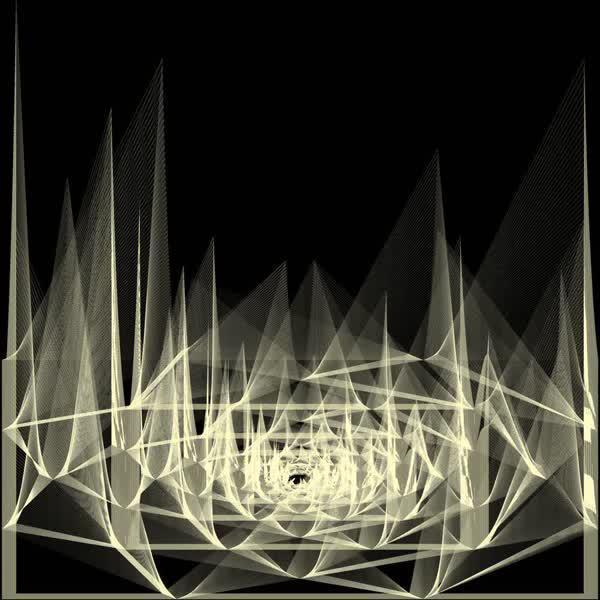 Variation on 'Root two flower'
Variation on 'Root two flower'

Here I described how these pieces are made. In this blog I like to illustrate it with more visuals, so it should be easier to understand.
The Root Two Flower
I start with iterating squares inside a bigger square. The starting point of each next square, is relative to the previous square. I chose a fixed ratio, so every next square has the same relation to the previous square.
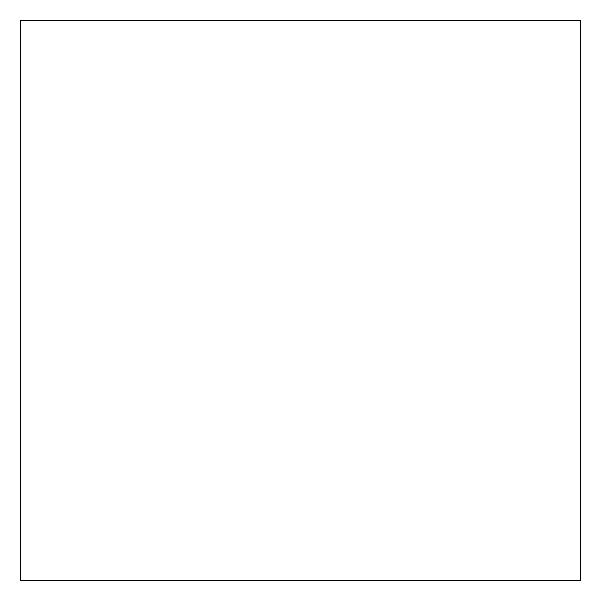
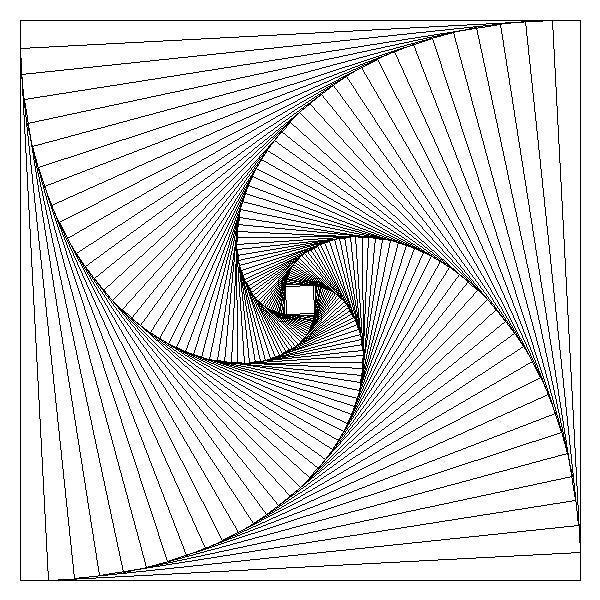
For the animation on the left, this ratio is 0.2. For the image on the right, the ratio is 0.05 and there are 60 iterations. When this ratio is 0 or 1, every next square will be a copy of the previous square. When the ratio is 0.5, every next square will be drawn from the midpoint of each line segment: every next square seems to be rotated 45 degrees, and the area of every next square is half of the area of the previous square. In the animation below, the number of iterations is fixed at 10, but the ratio increases from 0 to 1 in steps of 0.05.
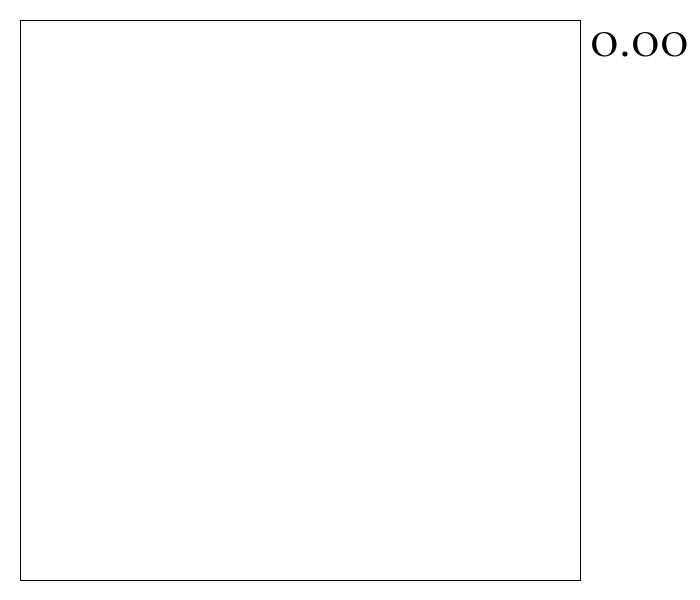
The curves that appear are called 'Pursuit curves'.
In the examples above, the direction is always counter-clockwise. This could also be done clockwise. So now I want to see what happens if the iterations happen in both directions simultaneously:
Again, at ratio 0 at 0.5 and 1, everything overlaps, but in between there will be many intersecting lines. A very interesting point is at 0.707 and 0.293. Here the intersecting lines seem to line up really nicely. The exact value can be easily determined, it is at ratio sqrt(2) / 2 and 1 - (sqr(2) / 2). So the 'magic number' is half a square root of two. This shape reminds me of a flower, so that's why I called it the Root Two Flower. (In my next blog, I will show this idea for a lot of other n-gons)
In the description for the Bridges conference, I made a wrong statement. I said that the above process will divide the plane in triangles only. In the first picture below, you can see that this is not the case. There are 'kites' (4-gons / quadrilaterals). So I added another iteration of squares, that divided every kite in two triangles, and also divided the large triangle in 3 small triangles. You can see this in the second picture below. Now the plane is divided into triangles, and in a way that is two-colorable as well!
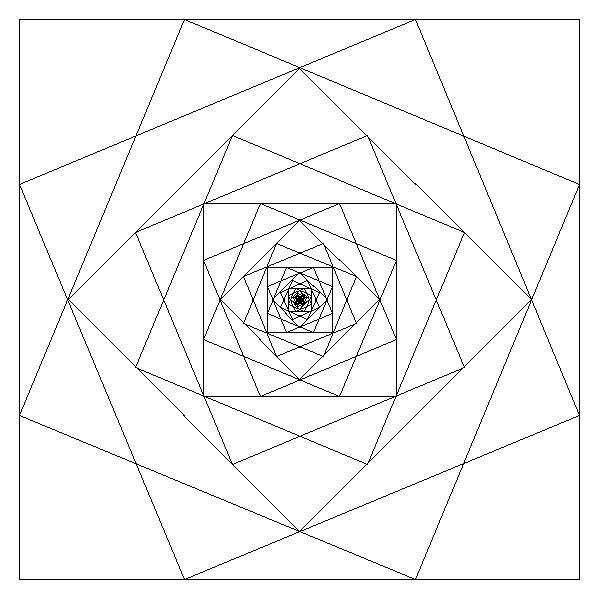

The Root Two Tunnel
Since the plane is now divided in triangles only. I decided to let those triangles iterate as well. I choose only clockwise or counter-clockwise direction. The division of the plane is two-colorable, so I can let every clockwise triangle neighbour to only counter-clockwise ones, and visa versa. I find this design way more elegant then when I put same direction iterations next to eachother. In a future blog post, I will show more results of 2 and 3-colorable tilings of the plane, that I filled with iterating polygons. In the Instagram post below, you can see what I mean when all the triangles of the 'Root Two Flower' iterate inside eachother. The first piece 'The Root Two Tunnel' is made this way.
Variation on 'Root two flower'
This variation is a lot more difficult to describe exactly, so I only give the idea briefly. Here I played with the logic in my code (everything has been generated by Python code written by myself). One of the main things I did was adding a fixed value to each iteration. So instead of triangles getting smaller and smaller with a fixed ratio, they will not get smaller, but they shift in a certain direction (for example upwards) with a fixed steps in pixels. This is why the shape now seems to grow out of the original 'flower'. All results are resized to a square, some variations became actually very thin rectangles.
In the code I designed twelve points where I could choose from two different options. So there are 12**2 = 4096 different variations. But the outcome for many of them appear to be the same. I found out I can make a couple of hundreds different variations. In the following animation, I show 12 different variations on the root two flower, one of them is the second piece I submitted for the Bridges conference.
Here is another animation. You can see that I divided the plane into triangles as described above. Those triangles can be stretched out and shrinked, as shown in the first 10 seconds.
Concluding notes
Hopefully the visuals in this blog made it clear how the two pieces are made. There is a lot more to be explored with the idea of iterating polygons inside eachother in two directions simultaneously. In my next blog I will show some really nice results for a series of n-gons. I am sure someone did this before, so if you read this and know more about it: please send me an e-mail. I am looking for the terminology. Is there a generally accepted term for the pattern that I call the 'Root Two Flower'? Is the process of iterating two polygons inside eachother described and studied already? Of course there are a lot of geometric properties that can be described in those patterns. If this is studied already, I am very happy to hear about it, and I will update this post with some links.
Final note: it takes me a lot of time to write this. So for this reason it is impossible for me to explain all of my work. For now, I will mostly write about observations I made that raised a lot of questions that I would like to get answered. By writing about it, I hope people will point me to the right paper / study / terminology where I can find my answers, or just connect with people who are interested in similar topics.